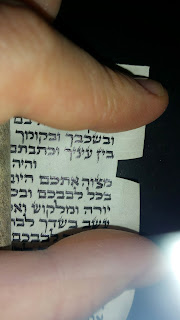Popular posts from this blog
Klaff Tanning question:
By
Rabbi Eli Gutnick
-
I received this question via email. I am not really a klaf expert, I was wondering if anyone could answer this question: Dear Rabbi Gutnick, I am writing to you because a good friend of mine has put the idea into my head that the klaf in my tefillin were not really tanned and therefore are not kosher. He referred me to Megilla 19a re diftera. From the research that I have done so far, it seems that the klaf that is used today is tanned only with a lime wash. On all of the tanning websites I’ve seen so far, they say that the lime doesn’t accomplish tanning but only the removal of the hair and some other pre-tanning effects. Would you be able to explain to me or refer me to a website that explains how the tanning process that is used today takes the hide out of the category of diftera? Thank you very much.
Rabbi Reuvain Mendlowitz clarifies his position on Ksav Chabad (and my final thoughts)
By
Rabbi Eli Gutnick
-
Last week I posted some thoughts in response to a public lecture given by Rabbi Reuvain Mendlowitz regarding Ksav Chabad (the Alter Rebbe's ksav). I felt he did not represent the issue fairly, and since I had received questions about it from a number of people I felt it made sense to write a general response. After I posted my response on this forum, Rabbi Mendlowitz reached out to me by email and we ended up having a respectful and productive email exchange regarding the relevant issues surrounding Ksav Chabad. His position is a lot clearer to me now, and I think he also took certain things on board that I clarified with him. The purpose of the Stam Forum (at least back in it's heyday before all the whats app groups took over) was to connect sofrim from around the world, to promote achdus and build bridges, as well as to offer support and advice. In that spirit, I felt I should write a follow up post, to clarify some of the issues and misconception...



So you can see it when it's rolled up...
ReplyDeleteWell yes, but why mutilate the Mezuza?
DeleteBecause the cutting doesn't affect the Kashrus of the mezuza and there is a strong minhag to see the shakai. It just doesn't look so nice.
ReplyDeleteI should point out though that if the cutting were to go into the parsha stuma it would present a problem...
This is often done by sfardi mezuzos. The put the shakay further in so it's one of the ways you can still see it after its rolled.
ReplyDeleteThe second way is to fold the right margin. I prefer that method to cutting
I've never heard any discussion or asked Rav Friedlander about folding the right side so I don't know which is better. This is also an issue on high end mezuzahs where they leave a margin of blank klaf for k'dei lagol. Rav Friedlander did suggest that its better to cut the klaf and make a flap and fold it back rather than remove the piece completely. The best eitzah is, if possible, to use a case that doesn't require the klaf to be rolled tightly.
ReplyDelete